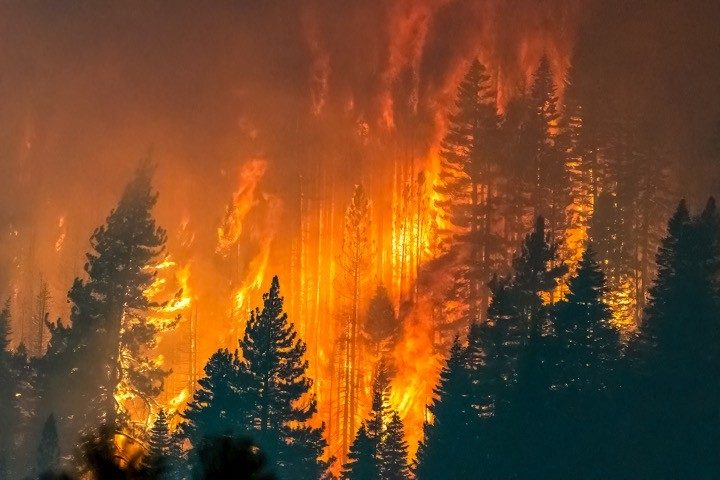
Forest fires in the American West have been quite destructive for decades, enhanced by cyclical droughts, pine beetle infestation, tree-hugging environmentalists, and poor forest and land management by federal and state government. This has led to questioning how best we can save our forests and return them to a more natural and healthy condition that will benefit man and wildlife alike.
Last month, the Property and Environment Research Center (PERC), a “free market environmentalism” nonprofit, released a publication entitled Burn Back Better: How Western States Can Encourage Prescribed Fire on Private Lands, which recommends immediate policy changes to address the growing wildfire crisis in the western U.S.
According to the report’s introduction:
For millennia, Indigenous communities managed forests in the American West with fire to produce a range of environmental and cultural benefits. This long history of cultural burning combined with frequent lightning produced fire-adapted forests, woodlands, and savannas. For more than a century, however, the federal government and states pursued an aggressive policy of fire suppression that effectively removed fire from the landscape. While this policy has mostly been abandoned, its effects linger in the form of overgrown forests, policy barriers, and cultural obstacles to restoring beneficial low-intensity fires at the scale needed to improve forest resilience and reduce wildfire risks.
Because of state and federal government’s continued failure to manage our forests properly, the West has suffered from catastrophic “megafires” that “scorch forests, degrade water quality, decimate habitat, and choke the air with smoke.” The report claims that “since 2005, the United States has three times eclipsed 10 million acres burned by wildfires in a year — an unfathomable total just a few decades ago — with the vast majority of that acreage concentrated in the West.”
In 1988, a megafire burned 1.4 million acres in the Greater Yellowstone Ecosystem, including 793,880 acres of the national park. At that time the National Park Service (NPS) had a “let nature take its course” policy, which garnered the service’s leadership well-deserved scrutiny by the press and politicians. Then President Ronald Reagan weighed in, calling what everyone dubbed the “Let It Burn” fire policy “a cockamamie idea.”
Since then, the NPS and U.S. Forest Service have changed forest firefighting policy, but have yet to allow a return to healthy forest management policies to end the risk of future megafires. The governments kneeling to environmentalist demands that seek to stop harvesting of dead trees, removing endangered species habitats, and saving old-growth areas from loggers have actually helped to destroy the forests they supposedly want to protect.
The lack of a good natural forest-fire prevention policy has indirectly added fuel to climate change radicals’ false narrative, as wildfires have reportedly “killed between 13 and 19 percent of the world’s remaining giant sequoias in the past few years.” Plus, according to the report, those fires have “released massive quantities of harmful air pollutants, including 112 million tons of carbon dioxide in California alone during 2020 — the equivalent of adding 25 million cars to the state’s roads.”
The solution to the wildfire crisis that is being offered is the “use of prescribed fire, in which low-intensity fire is carefully applied to a landscape under controlled conditions to improve forest resilience, reduce extreme wildfire risks, and achieve other land-management objectives.” Fires that occur in areas intentionally managed with prescribed fire to increase resilience have become less destructive and easier to fight.
“The benefits of prescribed fire were evident in Oregon’s Bootleg Fire, which burned more than 400,000 acres in 2021. In the wake of the fire, the landscape revealed huge differences between areas that had been unmanaged, mechanically thinned, or both mechanically thinned and managed with prescribed fire, with the latter producing the most resiliency.” The report also noted that “because of the unnatural buildup of fuels, prescribed fire often cannot be applied unless western forests are first thinned to produce safe conditions.”
The thinning of forests faces a huge roadblock, though, as current U.S. Forest Service tree-removal policies are limited to removing trees along powerline and forest-road corridors and wherever trees pose a risk to personal safety. These policies have allowed millions of pine trees killed by beetles to stand and lay dead across the West, becoming a potential tinderbox waiting to ignite; a fire risk that is ignored because of strict tree removal policies designed to give habitat to wildlife and fauna.
The Center Square reported:
“A key solution to the wildfire crisis is more fire, not less,” Jonathan Wood, vice president of law and policy with the Property and Environment Research Center and co-author of the report, said in a statement. “To ramp up prescribed fire and cultural burning, states must adopt policies that mitigate risks without being so onerous that they discourage landowners from using prescribed fire.”
The bottom line is that to end the megafire cycle in the West, federal and state regulations need to quickly change to allow thinning, prescribed fires, and overall good fire management to be implemented. Allowing private responsible forest management is the next step to helping ensure healthy forests for the next millennia.




